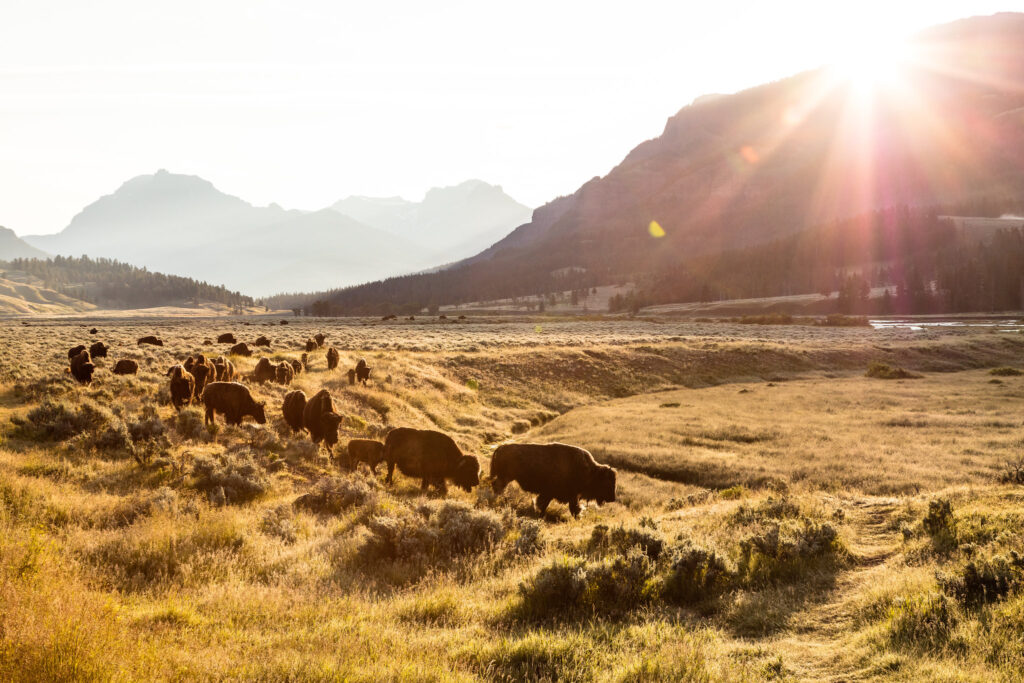
Bison move north out of Lamar Valley in Yellowstone National Park (Photo by Jacob Frank of the National Park Service | Photo via Flickr).
By this time next week one of the worst election seasons in the nation’s history will be over.
There are already plans being laid and voices being raised that, once again, intend to claim virtually non-existent voter fraud if a certain party or candidate doesn’t win. We’ll see how all that shakes out, but in the tidal wave of misinformation, obfuscation, outright lies and baseless claims, it’s worth thinking about what didn’t get mentioned by the state or national campaigns. And in that regard, the silence was deafening.
We surely heard a lot about farmers and soldiers, but what we didn’t hear was what to do about the grim and continually repeating slaughter of our national mammal — Yellowstone Park’s last pure gene pool of wild buffalo.
Those bison belong to all Americans, and whether the cattle industry likes it or not, it’s a federal issue dealing with a fragile resource that once again faces mass killing as the “solution” to keep the population at an arbitrary “management” level.
But in fact the Park’s plan is exactly backwards. They plan to kill somewhere around 1,300 bison — a shocking 25% of the entire herd — and send a handful off to tribes. What they don’t plan to do is move the federal bison to other federal lands — and Montana not only has an abundance of federal lands, we have the perfect place to relocate “surplus” bison from Yellowstone. Namely, the huge Charles M. Russell Wildlife Management Area and the UL Bend Wilderness Area of the majestic Missouri River Breaks.
Yet, that topic, like so many others that are pressing but contentious, remained unaddressed. And more’s the pity when you consider the first Native American cabinet member, Secretary of the Interior Deb Haaland, could have and should have taken steps to move those bison to safety and freedom instead of slaughter houses and meat grinders.
Or, how about what to do to keep water in Montana’s rivers as the climate-driven drought cycle decimates these once world-famous wild trout streams? One may have expected candidates for both state and federal offices to address the issue since it’s now gone national and international, highlighted by the crashing trout populations in the Big Hole River.
But again, nope.
Our so-called and wannabe “leaders” could have stepped forward with a plan to appropriate federal and state dollars to buy out water rights and keep the rivers flowing. But no, they didn’t talk about that because it’s apparently too controversial. So too bad for the aquatic ecosystems, the wild trout, and the economies they sustain.
Since the core of many of the state and nation’s increasingly severe problems are fueled by the overabundance of greenhouse gas pollution in the atmosphere, one may have expected that particularly serious issue to get attention.
As the The 2024 State of the Climate report: Perilous times on planet Earth, succinctly put it: “We are on the brink of an irreversible climate disaster. This is a global emergency beyond any doubt. Much of the very fabric of life on Earth is imperiled.”
Yet the closest we came to hearing campaigns address this “irreversible climate disaster” was “drill baby drill” and “frack, frack, frack – like a duck.” Oh, and keeping Colstrip and the military industrial complex adding to the on-going climate disaster.
The list goes on and on far beyond the limits of one column. Simply put, the hard issues aren’t going away, no matter how much candidates dodge them.
Yet not talking about them only ensures one thing — they will get worse.
We deserve better — but their silence was deafening as they groveled for votes.

